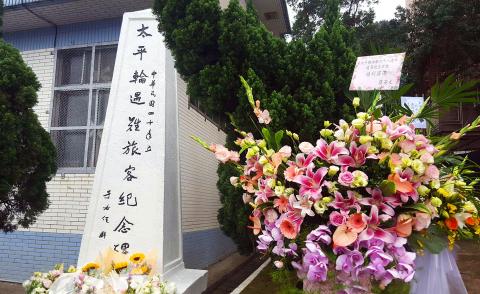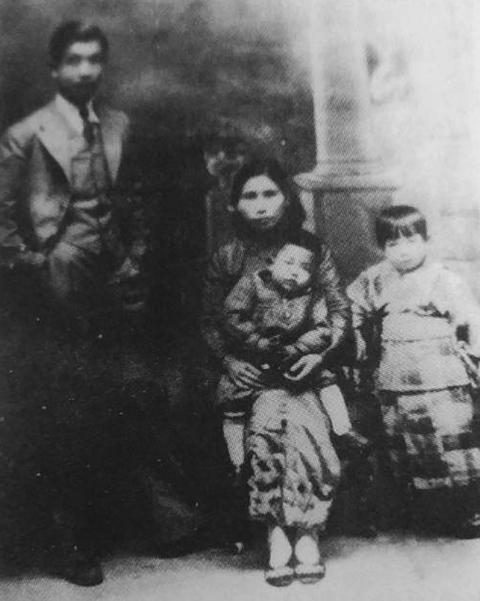Jan. 22 to Jan. 28
A nine-year-old Henry Lee (李昌鈺) was excited to be spending the Lunar New Year with his father, who would be arriving in Taiwan from China on a ship. Two days before the festivities, on Jan. 27. 1949, the future famous forensic scientist noticed that the adults were acting strangely. They did not tell him until two days later that his father had perished in the Taiping steamer (太平輪) tragedy.
More than 1,000 people died that night as the Taiping, which was headed from Shanghai to Keelung, collided with the Chienyuan (建元輪), a cargo ship from Taiwan. The Chienyuan immediately sank, while the Taiping went down 45 minutes later. About 50 people survived.

Photo: Yu Chao-fu, Taipei Times
The common version of events state that the crash occurred for several reasons, one being that the Taiping had exceeded its capacity with Chinese refugees escaping the Chinese Civil War, which had turned in favor of the Chinese Communist Party (CCP). It’s also said that it did not have its lights turned on because it was sailing during a nighttime curfew due to a delayed start. Some accounts also state that the captain had tried to take a shortcut.
Ting Wen-ching (丁雯靜) writes in the book, Taiping Steamer: Legend in Troubled Times (太平輪: 亂世傳奇真相), that through the making of a documentary on the incident, she began feeling that the official explanation was a bit fishy.
EYEWITNESS ACCOUNTS

Photo: CNA
Ting writes that the ship was flawed from the beginning. The Taiping was originally designed to traverse rivers and was only supposed to carry a maximum of 508 people. The boat also had too much cargo and likely more unregistered passengers who snuck on board. Lee’s father was one of them, making it onto the ship because he knew the captain. So was Chang Sheng (張生), one of the few Taiwanese on board who was returning home from a business trip.
The goods included official documents, bonds from the national treasury, rare antiques and the entire printing press of the Southeastern Daily (東南日報).
The passengers on the Taiping started rescuing the Chienyuan crew members until they realized that they too were sinking. Another ship had earlier passed the Taiping and asked them if they needed help. Not realizing the gravity of the situation, the Taiping replied, “All Okay.”
The Taiping crew attempted to steer the ship toward a nearby island — but it capsized 500 meters before landing. Survivor Lee Shu-wen (李述文) says that everyone fell into the water at once as the boat tipped over.
“I saw a sea of heads leaning on planks, tables and luggage,” he says. “Everyone was screaming... It was horrific to see and horrific to hear.”
It was around dawn when an Australian ship, the HMAS Warramunga, picked up 34 survivors from the wreckage. Almost all of them had at least one family member who didn’t make it.
John Simmons of the Warramunga still remembers the frightened expressions of the survivors, who were completely covered in oil that had leaked from the ship. “Besides their eyes and teeth, they were completely black,” he says.
DISPROVING THEORIES
Ting lists the various conspiracy theories that surround the incident: there was gold on board, a fight broke between Chinese Nationalist Party (KMT) and CCP spies, the ship was bombed and the captain of the ship was a Communist.
Since the wreckage has not yet been recovered, Ting writes that it’s hard to come up with a definite answer to quell the rumors. But she found many conflicting reports while interviewing eyewitnesses.
Ting questions whether the ship was overloaded, but concludes that even if it was, it did not necessarily lead to the crash. She focuses on why the ship’s departure was delayed — and traces it to a last-minute addition of 600 tonnes of steel bars. The ship would have left hours earlier if it did not have to wait for the bars to arrive.
Some reports say that the boat was speeding, but Ting argues that a river boat filled to the brim with people and cargo would not have been able to go too fast. As far as the two ships taking shortcuts, Ting maintains that both followed their regular courses, noting that there was not much reason for them to cut corners.
After extensive interviews with survivors, Ting finds that the ship indeed had its lights off at the time of the crash. But she then wondered why nobody saw the Chienyuan, which had its lights on.
One crew member first testified that nobody was on watch, as the third mate had left the cockpit to use the bathroom before the second mate arrived to take over. As the crash happened at 11:45pm, that was possible as his shift would have ended minutes later. But as a witness in court 90 days later, the crew member completely changed his statement, stating that they noticed the Chienyuan but could not get its attention.
Finally, she noticed that the steel bars were not on the inventory list of the ship, but almost all witnesses saw the bars being loaded. Historian Wang Feng (王丰) tells Ting that in those days many KMT officials were in the smuggling business as their salaries would not be enough to get their families out of the country if things went south.
“The Taiping was likely one of the vessels used by officials for smuggling. If it did not have to wait for those bars, it could have left Shanghai on time, and the ship may not have sunk,” Wang says. “These 600 tonnes of bars are an important clue.”
SLIGHTLY DIFFERENT VERSION
One of the other few recent books about the incident is Taiping Steamer 1949: Journey Toward Taiwan (太平輪一九四九:航向台灣) by Chang Tien-wan (張典婉), published in 2014.
Her version states that the ship was loaded far beyond capacity, and also mentions the 600 tonnes of steel bars that caused a delay. A frequent passenger tells her that he would normally have to climb a ladder to board, but the boat was so weighed down that he was able to walk on.
Chang’s story differs from Ting’s where she states that since the ship was running during curfew, it turned its lights off and took a shortcut to avoid running into the military. Her version also brings blame on the third mate, who she writes forgot to adjust the rudder because the first mate was drunk.
Taiwan in Time, a column about Taiwan’s history that is published every Sunday, spotlights important or interesting events around the nation that have anniversaries this week

Exceptions to the rule are sometimes revealing. For a brief few years, there was an emerging ideological split between the Democratic Progressive Party (DPP) and Chinese Nationalist Party (KMT) that appeared to be pushing the DPP in a direction that would be considered more liberal, and the KMT more conservative. In the previous column, “The KMT-DPP’s bureaucrat-led developmental state” (Dec. 11, page 12), we examined how Taiwan’s democratic system developed, and how both the two main parties largely accepted a similar consensus on how Taiwan should be run domestically and did not split along the left-right lines more familiar in

As I finally slid into the warm embrace of the hot, clifftop pool, it was a serene moment of reflection. The sound of the river reflected off the cave walls, the white of our camping lights reflected off the dark, shimmering surface of the water, and I reflected on how fortunate I was to be here. After all, the beautiful walk through narrow canyons that had brought us here had been inaccessible for five years — and will be again soon. The day had started at the Huisun Forest Area (惠蓀林場), at the end of Nantou County Route 80, north and east

Specialty sandwiches loaded with the contents of an entire charcuterie board, overflowing with sauces, creams and all manner of creative add-ons, is perhaps one of the biggest global food trends of this year. From London to New York, lines form down the block for mortadella, burrata, pistachio and more stuffed between slices of fresh sourdough, rye or focaccia. To try the trend in Taipei, Munchies Mafia is for sure the spot — could this be the best sandwich in town? Carlos from Spain and Sergio from Mexico opened this spot just seven months ago. The two met working in the

This month the government ordered a one-year block of Xiaohongshu (小紅書) or Rednote, a Chinese social media platform with more than 3 million users in Taiwan. The government pointed to widespread fraud activity on the platform, along with cybersecurity failures. Officials said that they had reached out to the company and asked it to change. However, they received no response. The pro-China parties, the Chinese Nationalist Party (KMT) and Taiwan People’s Party (TPP), immediately swung into action, denouncing the ban as an attack on free speech. This “free speech” claim was then echoed by the People’s Republic of China (PRC),